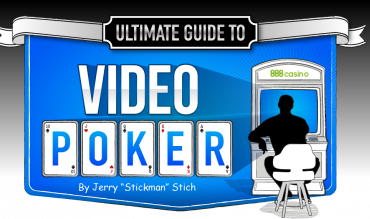
VIDEO POKER STRATEGY
So far in this video poker guide you have learned how video poker started and grew. You have learned the basics of video poker play including return, house edge, and variance. You have learned about how randomness works while playing at the casino. You now know how to determine your bankroll size. You may even know what specific video poker game (or games) you want to play. If you do not, you have some idea how different video poker games behave and their major characteristics.
In this chapter you will learn all about video poker strategy. You will learn what it is, how it is developed, and most importantly, you will learn a major key in how to win at video poker. Every session may not be a win, but if you understand and follow the information in this chapter, you will have the best shot of winning at video poker.
HOW TO WIN AT VIDEO POKER
Because video poker players can decide which cards from each dealt hand to hold or discard, they can change the outcome of the game. Winning at video poker may not be easy, but if you follow the information presented in this guide, you can win at video poker.
Winning at video poker involves several things which are all included in this guide:
- Choice of game and pay table – Return and variance
- Adequate bankroll
- Perfect playing strategy
- Playing that strategy perfectly
- Money management
- Discipline
Playing the perfect strategy perfectly is the key for how to win at video poker. This chapter covers strategy in detail. Pay attention to what is here.
It is assumed that you know the makeup of all the different poker hands. For example, you must know what constitutes a flush, a straight, a straight flush, a full house and so forth. If you do not know or you are unsure, check the glossary of this guide to learn or to refresh your memory.
Are you ready to learn about strategy, a key component of how to win at video poker?
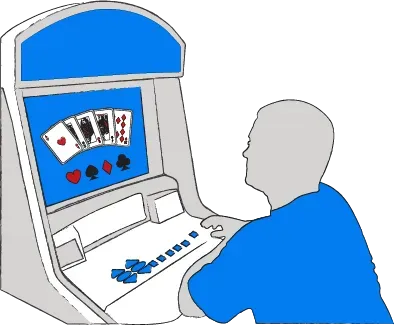
Of course you are. Let’s go.
![]()

WHY USE A STRATEGY?
Slots are extremely popular. One of the reasons for their popularity is that they are easy to play. The only skill that is necessary is to be able to insert money into the game and press a button or pull a lever to start play. That is it. From that point on, everything that happens depends on luck. The results of slot machine spins are based totally on randomness. The instant the slot player presses the spin button the result of that spin is locked in. Whether it is (most likely) a loser, a small winner, a moderate winner, or a jackpot winner has already been decided. Slot players can do nothing to change the odds either for or against them.
Some slot machines allow the player to hit a stop button that immediately stops the reels from spinning and show the result, but hitting that button makes no difference in the result of the spin. Whatever was determined at the instant the spin started is the result.
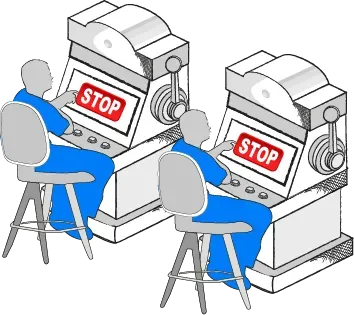
Unlike slot machines, video poker games allow players to have a say in the game they chose to play. Like slot machines, randomness is also involved. The instant the “Bet Max Credits” or the “Deal / Draw” button is pressed the five cards to be dealt are determined based on a random process. After the cards to be held are selected by the video poker player, the cards that replace those not held are also determined by a random process at the instant the “Deal/Draw” button is pressed.
But that is where the similarity with random slot machine play ends. The video poker player has total control over the initial five cards that have been dealt. It is his or her choice what to do with those five cards. The decisions about whether to keep all of them, discard all of them, or anything in between is totally theirs. It is actually totally yours. After all, you are the one reading and learning from this guide.
You could choose to throw away the entire hand and hope to be dealt a royal flush. You could also choose to hold just the ace and throw away the four 3s and, again, hope for a royal flush. With this hand it should be very obvious that you would make the most money by saving the four 3s and collecting the winnings for a four of a kind.
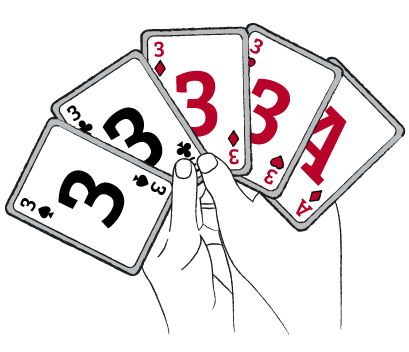
Here is another example that might not be quite as obvious. Assume you are dealt four cards of a royal flush in spades and an ace of diamonds.
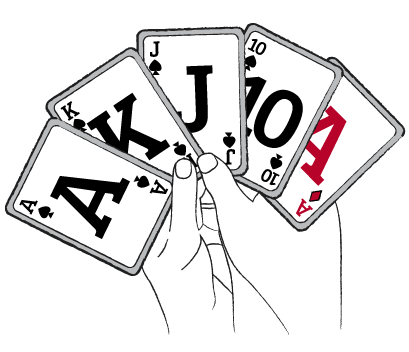
In this case you have a high pair of aces as well as four cards of a royal flush. What do you save? Do you save the high pair for a sure win and a possible four of a kind? Or would you rather take a shot at the royal flush? This is not quite as easy as the last hand.
Here is another example along the same lines as the previous hand. Assume you are dealt a flush in spades. Here is your hand: Ks Qs Js Ts 3s.
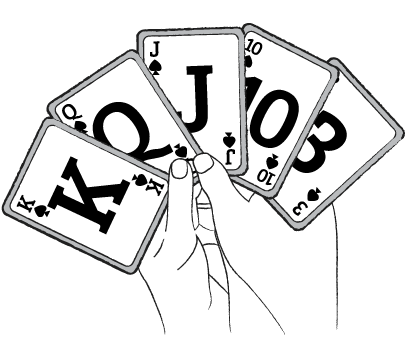
While you have total control over the five cards that have been dealt, not every decision that you might make has the same impact. To use an extreme example, let us assume you are dealt a hand containing four 3s and an ace.
What would you do here? Would you save the straight flush consisting of the 9 of spades through the king of spades? Or would you decide to save the four cards of a royal flush and once again hope for lightning to strike?
A straight flush pays very well, but a royal flush pays many times more. This is a truly difficult decision. Obviously you will not run across hands such as these very often, but they do demonstrate a point. That point – each hand that is dealt is a unique situation. How you decide to handle that situation could make a big difference in the outcome of the hand. The same situation happens at a much less exciting level in each and every hand that is dealt.
Again, the choice is totally yours. Do you save the flush for the sure win? Or would you rather save the four cards of a royal flush and hope to hit the jackpot? Since a flush pays quite a bit more than the high pair that was in the previous example, the decision with this hand is even harder to make.
Making the proper decision on which cards to hold and which to discard is the essence of how to win at video poker. Make the proper decision every time and you have the best shot of winning at video poker. Of course, there are other actions required to win at video poker, but employing the proper strategy is critical. Everything you need to know about how to play video poker and win are included in this guide.
To be honest, most video poker hands leave very little doubt as to the best way to play the hand. It does not take a lot of skill or intuition to know what to do when dealt a hand such as the following:
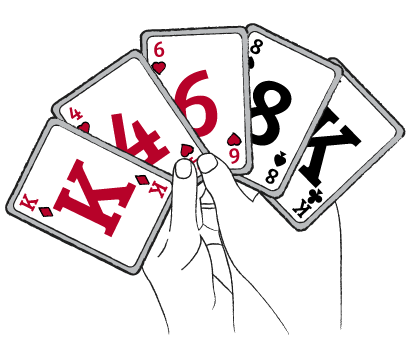
It should be obvious that the proper play is to hold the two kings. There is really nothing else worth saving in the hand. This tends to be the case for most of the hands that you are dealt.
But what about the hands where there is more than one viable option? What should you do then?
Most video poker players make their decisions about what to hold and what to discard based on intuition or hunches. In this hand: 4c 5c 6c 7d Ts.
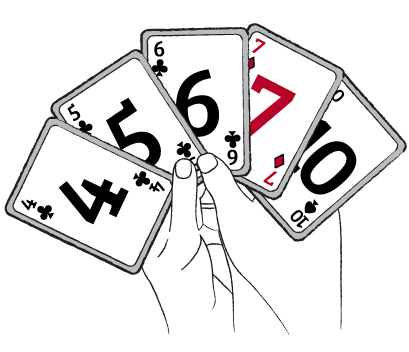
They “feel” that holding three cards of a straight flush is a better play than holding four cards of a straight. This type of video poker player bases every hold decision on what he or she feels is the best play.
Other video poker players like to keep track of the “flow” of the game. Are there a lot of high pairs? How about straights – are they happening fairly frequently? Have there been streaks of full houses or flushes? These players make their hold decisions based on how the cards have been flowing in the recent past.
Holding cards based on what you feel is correct or holding based on the flow of the cards are both technically strategies. But the video poker game manufacturers set up pay tables based on the math of the game so the casinos will be sure to make a profit from them. Therefore in order for you to make the most of your video poker playing experience, you need to use a strategy that is based on the same math.
Playing hunches or streaks may work for a hand or two (or possibly even a session or two), but far more often these tactics will not work. In fact, by employing these types of playing strategies, you will end up giving the casino even more of your hard earned money than you need to. Only by using mathematically derived video poker playing strategies will you get every cent you can from your video poker play over the long run.
Obviously you will not run across hands such as these very often, but they do demonstrate a point. That point – each hand that is dealt is a unique situation. How you decide to handle that situation could make a big difference in the outcome of the hand. The same situation happens at a much less exciting level in each and every hand that is dealt.
To be honest, most video poker hands leave very little doubt as to the best way to play the hand. It does not take a lot of skill or intuition to know what to do when dealt a hand such as this one Ks Kd 3h 6c 8s.
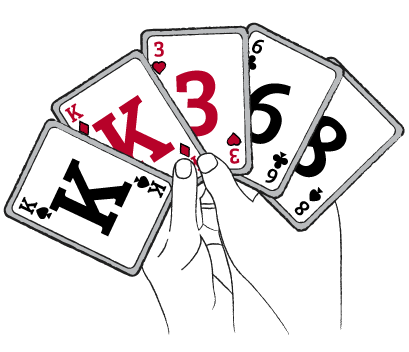
![]()
KEY TAKEAWAYS
![]() Unlike slot players, video poker players have a say in the outcome of the game.
Unlike slot players, video poker players have a say in the outcome of the game.
![]() Because the player has a choice in video poker play, it is possible to play the hands in a way that is most beneficial to the player.
Because the player has a choice in video poker play, it is possible to play the hands in a way that is most beneficial to the player.
![]() Most video poker players use hunches or play streaks.
Most video poker players use hunches or play streaks.
![]() Only a mathematically derived video poker playing strategy will get you the most from your video poker play.
Only a mathematically derived video poker playing strategy will get you the most from your video poker play.
![]() Playing the proper mathematically derived strategy, and playing that strategy perfectly, for each game and pay table is the key factor in how to win at video poker.
Playing the proper mathematically derived strategy, and playing that strategy perfectly, for each game and pay table is the key factor in how to win at video poker.
![]()

STRATEGY CHART BASICS
You learned in section 6.1 that using a mathematically derived video poker playing strategy is how you get the most out of your video poker play.
What exactly is a video poker playing strategy? How is it derived? What does it look like?
All those questions and more are answered in section 6.2. Let’s begin
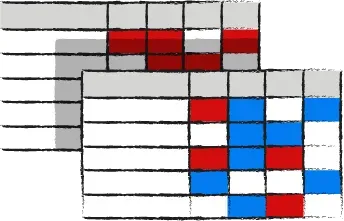
HOW VIDEO POKER STRATEGY IS DEVELOPED
There are several different ways to develop a video poker playing strategy. It could be tailored to favor hitting royal flushes. A strategy developed in this way could be useful in video poker tournaments where the participant has a limited amount of time to get a high score in order to win. This type of strategy would see a greater number of royal flushes. It would however also see a smaller return to the player because smaller winning hands would be sacrificed in favor of holding for a royal flush.
Another type of strategy could favor winning as many hands as possible regardless of the amount of the win. For example, any time a high pair is dealt it would be saved even if there were decent shots at a royal flush or other higher paying results in the same hand. This type of strategy may find the player winning more hands, but the amount won per hand would be significantly less than is possible.

MOST WINNING HANDS SIMPLY ALLOW ADDITIONAL HANDS TO BE PLAYED
Think about how normal video poker play goes. After depositing your initial amount, you start playing hand after hand. Most often you lose your bet. The next most frequent occurrence is to simply get your bet returned by hitting a high pair (or sometimes two pairs) that returns 1 for 1. You will also hit other higher paying but less frequent hands. In each case, however, unless you hit a royal flush or other very high paying hand such as four aces with a kicker, the amount you win is not enough to cash out and be considered a good win for the day. Instead, all of these lesser wins are really just extra money that allows you to play a few more hands in order to try to win the jackpot sized hand(s).
With this in mind, the optimal strategy is one designed to win as much as possible from each initial hand dealt. In this way the player will get as many hands as possible to chase the coveted jackpot sized hands.

The process for developing the strategy charts is a tedious one. There are 2,598,960 possible five card hands in a 52 card deck. Here is a table showing all the possible video poker hands for a non-wild card video poker game.
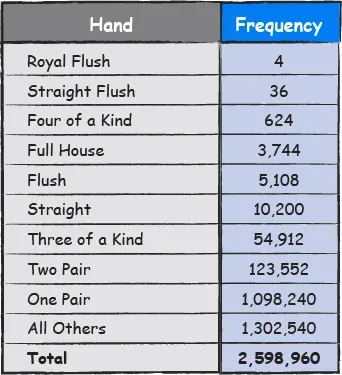
Each of the 2,598,960 hands must be examined. Each possible hold combination for each of these hands must then be examined to determine all possible resulting hands and the returns for them. Take this sample hand: As 3s 4h 5c Kd.
All possible resulting hands and pays for a hold of just the ace of hearts must be calculated. The same must then be done for a save of just the 3 of spades, the 4 of hearts, the 5 of clubs, and the king of diamonds. Then the same must be done for each possible hold of two cards. Then the same is done for holds of three cards. The same is done for holds of four cards. Finally the return for a hold of all five cards is calculated. The returns are then compared in order to select the best possible hold (in terms of money returned). The results for each of the over two and a half million possible hands are summarized in order to develop the strategy.
As you can see, this process is not easily accomplished by hand. It is not something you could do by sitting down at the dinner table with a pad of paper and a pencil. It is only feasible if a computer program is used.
HOW A VIDEO POKER STRATEGY CHART IS ARRANGED
The strategy charts for all non-wild card games are organized the same way. The hand with the highest average return goes at the top of the strategy chart. For most video poker pay tables that hand is the royal flush. It is followed by lower paying hands and partial hands in order of decreasing return. Keep in mind that partial hands that are not winners themselves will at times be included above hands that are winners because they have an average return (for all possible outcomes) that is higher than a dealt winning hand. For example, in most games four cards of a royal flush is listed above a full house because of the possibility of that hand turning into a royal flush. However, that is not the only hand that can be made from a hand with four cards of a royal flush. There is also the possibility that the hand could become a straight flush, a flush, or a straight with the proper cards being drawn. See the examples below.
The process of listing hands with an ever lower average return continues until the average return for the hand is less than the average return for a totally new hand. The word “Redraw” or words to that effect are placed at this point in the strategy chart. This means you will get a higher return by totally replacing your hand than by trying to make something of it. The strategy chart is now complete.
Now you know the basics of video poker strategy charts and are ready to learn exactly how to use them. Section 6.3 has what you need to know.

KEY TAKEAWAYS
![]() Only a mathematically derived video poker strategy will give you the best return. It is the key for how to win at video poker.
Only a mathematically derived video poker strategy will give you the best return. It is the key for how to win at video poker.
![]() With a few exceptions, wins on video poker simply finance the playing of additional hands.
With a few exceptions, wins on video poker simply finance the playing of additional hands.
![]() For the normal video poker player the proper playing strategy is one that will maximize the return of each hand.
For the normal video poker player the proper playing strategy is one that will maximize the return of each hand.
![]() In order to create an optimum playing strategy, results of all possible saves for over 2.5 million possible hands must be calculated.
In order to create an optimum playing strategy, results of all possible saves for over 2.5 million possible hands must be calculated.
![]() Video poker strategy charts are arranged so the most favorable holds are at the top followed by holds that steadily decrease in value.
Video poker strategy charts are arranged so the most favorable holds are at the top followed by holds that steadily decrease in value.

HOW TO USE VIDEO POKER STRATEGY CHARTS
Look in any casino gift shop and you have most likely seen little credit card sized blackjack strategy cards. This tiny little card contains everything you need to know in order to play blackjack perfectly. It would be very nice if the same thing were true concerning strategy charts for video poker games. Unfortunately, that is not the case.
Why not?
Strategy for the game of blackjack involves knowing when to take one of four possible actions based on the two cards you are dealt. The four actions are “stand” (play the two cards you are dealt as is), “hit” (take another card to try to better your two cards), “pair split” (if you have two cards of the same rank, make two separate hands out of them by adding another same size bet), or “double down” or simply “double” (add a bet equal to the original bet and take just one additional card). The only information you have to make this decision is your two cards and the card the dealer puts face up.
By making a grid with the dealer up card across the top, the two player cards on the left, and filling each spot with an abbreviation indicating the player action, everything needed for perfect blackjack play is easily contained in a very small space.
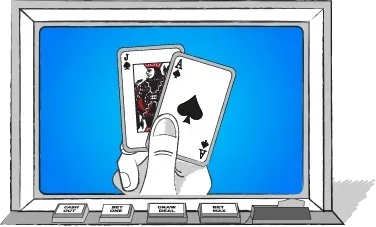
As you learned in section 6.2, the arrangement of a video poker strategy chart is different. The list contains the card(s) to hold in the first five card hand that you are dealt. The top line contains the cards to hold that give the highest average return. Each line below that has the cards to hold that will produce the next highest average return. This continues until the player is better off discarding the entire first hand rather than holding anything at all.
Let’s look at a sample of a video poker strategy chart. Here is a partial view of a strategy chart for a full pay (9/6) Jacks or Better game.
VIDEO POKER STRATEGY CHARTS #1:

As you can see, there are many different combinations of cards that can be held. Depending on the type of video poker game, there can be as many as 60 or 70 lines of strategy. Lines are sometimes combined in order to simplify the strategy. The first several lines of the strategy chart above could also be represented by:
VIDEO POKER STRATEGY CHARTS #2:
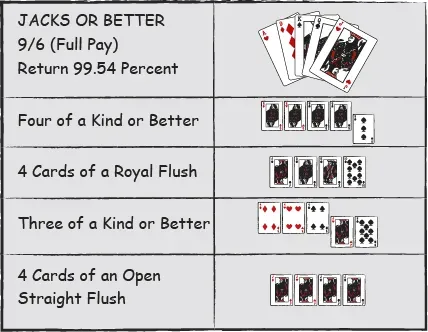
The number of lines represented above has been reduced to four from eight. The results of those four lines are exactly the same, however. Most strategy charts will combine multiple lines on a single line if possible.
To properly use these strategy charts it is important to know the difference between an open straight (or straight flush) and an inside straight (or straight flush). The term “open” is a shortcut way to say “open ended.” And that is exactly what an open hand is. Specifically, to be considered an open straight / straight flush the hand must:
- Have no gaps in the sequence of cards. Examples:
- The sequence 4 5 6 7 has no gaps so it could be an open straight / straight flush.
- The sequence 4 6 7 8 has a gap between the 4 and 6 so it is an inside straight / straight flush not an open straight / straight flush.
- Be able to be fully completed from either end of the straight / straight flush, i.e. open ended. Examples:
- 4 5 6 7 has no gaps and can be completed with a 3 or an 8 so it is an open straight / straight flush.
- Ace 2 3 4 has no gaps but can only be completed with a 5 on the high end. It is an inside straight / straight flush.
- 3 4 5 has no gaps and can be completed with an Ace 2 on the low end, a 2 6, and a 6 7 on the high end. It is an open straight / straight flush.
- 2 3 4 has no gaps but can only be filled by an Ace 5, and a 5 6 on the high end. It cannot be completed using two cards on the low end so it is an inside straight / straight flush.
I am spending time on this topic for a very good reason. Open straights and straight flushes are always listed higher in a strategy chart because they can be filled in more ways than an inside straight / straight flush. Therefore it is important that you know the difference when you play so you do not inadvertently consider an inside straight / straight flush as though it was open.
There is one other set of information you need in order to make correct use of a strategy chart - the sequence of hands from highest paid to lowest paid. You need this information to determine whether you have an “or Better” hand. For example, is the straight you have in your hand “better” than a three of a kind?
This information is listed in the pay table for the game you are playing. The 9/6 Jacks or Better the pay table looks like this:
Jacks or Better “Full-Pay” – Payback: 99.54 Percent, Variance 19.5

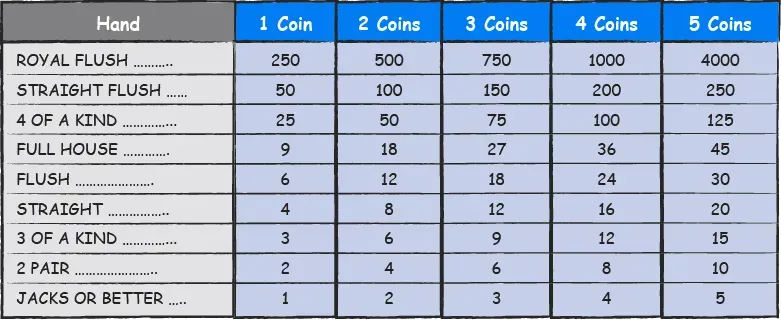
In the example above, yes, a straight is better than three of a kind.
One additional note – sometimes higher paying hands are listed beneath lower paying hands. The Double Double Bonus Poker pay table has the straight flush which pays 50 for 1 listed above all of the four of a kind hands. However, in Double Double Bonus Poker four of a kind hands pay between 50 for 1 and 400 for 1.
These pays range from equal to the pay for a straight flush to something much higher.
Therefore to properly determine the rank of the paying hand, look at the pays, not the position in the pay table.
Now that you know what a strategy chart looks like and the rules for its use, let’s look at some examples of using a strategy chart.
You are dealt the following hand: 6c 7h 8s 9d Td
The hand contains a straight (the 6 of clubs through the 10 of diamonds).
Let’s try one more hand and this time use Strategy Chart One. You are dealt Kd 4h 6h 8s Kc
![]()
![]() Start with the first line of the strategy.
Start with the first line of the strategy.
![]() Compare it with the hand you are dealt.
Compare it with the hand you are dealt.
![]() If your hand contains the cards listed, hold those cards and hit the Draw button.
If your hand contains the cards listed, hold those cards and hit the Draw button.
![]() If it does not contain the cards listed, check the next lower line of the strategy.
If it does not contain the cards listed, check the next lower line of the strategy.
![]() Continue doing this until you locate the cards in your dealt hand.
Continue doing this until you locate the cards in your dealt hand.
![]() If you reach the end of the strategy do not hold anything, simply hit the “Draw” button.
If you reach the end of the strategy do not hold anything, simply hit the “Draw” button.
![]()
![]() Look at the first line. It says “Four of a Kind or Better.”
Look at the first line. It says “Four of a Kind or Better.”
![]() Your hand does not contain four of a kind or better.
Your hand does not contain four of a kind or better.
![]() Go to the next line. It says “Four Cards of a Royal Flush.”
Go to the next line. It says “Four Cards of a Royal Flush.”
![]() Your hand does not contain four cards of a royal flush.
Your hand does not contain four cards of a royal flush.
![]() Go to the next line. It says “Three of a Kind or Better.”
Go to the next line. It says “Three of a Kind or Better.”
![]() You have a straight. Is it better than (does it pay more than) a three of a kind?
You have a straight. Is it better than (does it pay more than) a three of a kind?
![]() According to the pay table a straight pays 4 for 1 and a three of a kind pays 3 for 1 so it pays more than a three of a kind.
According to the pay table a straight pays 4 for 1 and a three of a kind pays 3 for 1 so it pays more than a three of a kind.
![]() Save the entire hand and hit the Draw button.
Save the entire hand and hit the Draw button.
![]()
![]() No Royal Flush
No Royal Flush
![]() No Straight Flush
No Straight Flush
![]() No Four of a Kind
No Four of a Kind
![]() No four cards of a royal flush
No four cards of a royal flush
![]() No full house
No full house
![]() No flush
No flush
![]() No straight
No straight
![]() No three of a kind
No three of a kind
![]() No straight
No straight
![]() No four card of an open straight flush
No four card of an open straight flush
![]() No two pair
No two pair
![]() No four cards of an inside straight flush
No four cards of an inside straight flush
![]() You have a high pair of kings. Hold these two cards and hit the Draw button.
You have a high pair of kings. Hold these two cards and hit the Draw button.
That is all there is to it. Using a strategy chart is quite simple. Besides that, by using one when you play video poker you ensure that you will have the best possible results against the casino.
KEY TAKEAWAYS
![]() Video poker strategy takes more space to display than blackjack strategy. There can be scores of lines.
Video poker strategy takes more space to display than blackjack strategy. There can be scores of lines.
![]() To properly use a video poker strategy chart it is important to know the difference between fully open and inside straights and straight flushes.
To properly use a video poker strategy chart it is important to know the difference between fully open and inside straights and straight flushes.
![]() You must also know the order of hands based on how much they pay.
You must also know the order of hands based on how much they pay.
![]() Though video poker strategy charts can be fairly lengthy, they are straightforward to use.
Though video poker strategy charts can be fairly lengthy, they are straightforward to use.
CHAPTER SUMMARY
In this chapter you learned how video poker strategy charts are created. The process is very computationally intense. By using the math of video poker to create a strategy that maximizes the return of every hand, the resultant strategy will have the highest return possible. You also learned that while there may be scores of lines in a strategy chart, the charts are straightforward to use.
In order to properly use a strategy chart the video poker player must know the relative amount paid for each different hand. They must also know how to determine whether a straight or straight flush is a fully open or an inside hand. There are several keys to winning at video poker. Correctly playing the mathematically produced strategy is a key component of how to win at video poker.
Having learned how to use a video poker strategy chart, you are ready to learn how to practice playing video poker in order to learn how to play without having to check a strategy chart for each hand. You will learn how to do this in chapter 7.
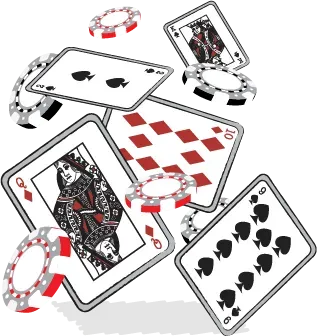
TEST YOURSELF
See if you can answer these questions based on the information presented in Chapter 6.
![]() True or False - Video poker players who play hunches or hold cards based on the flow of the game can do better than players who use a mathematically derived playing strategy.
True or False - Video poker players who play hunches or hold cards based on the flow of the game can do better than players who use a mathematically derived playing strategy.
Note: for the next few questions decide whether the partial hand shown is an open or an inside straight / straight flush
![]() 2 3 5
2 3 5
![]() 3 4 5
3 4 5
![]() 2 3 4
2 3 4
![]() A K Q J
A K Q J
![]() K J T
K J T
![]() True or False - It is never beneficial to discard your entire first five cards.
True or False - It is never beneficial to discard your entire first five cards.
ANSWERS
![]() Actually, this is somewhat of a trick question. If you are talking about a relatively short amount of play, the answer is yes they can do better than players using a proper strategy. As with all things based on randomness, it is possible that someone who plays hunches or bases their hold decisions on the flow of the game can do better than a player how strictly follows the proper strategy in the short term. In the long run, however, the player who uses the strategy will always come out ahead.
Actually, this is somewhat of a trick question. If you are talking about a relatively short amount of play, the answer is yes they can do better than players using a proper strategy. As with all things based on randomness, it is possible that someone who plays hunches or bases their hold decisions on the flow of the game can do better than a player how strictly follows the proper strategy in the short term. In the long run, however, the player who uses the strategy will always come out ahead.
![]() Inside. There is a gap between the 3 and 5.
Inside. There is a gap between the 3 and 5.
![]() Open. The straight can be fully filled on both ends of the hand – A 2 on the low end and 6 7 on the high end. It can also be filled with a 2 on the low end and a 6 on the high end.
Open. The straight can be fully filled on both ends of the hand – A 2 on the low end and 6 7 on the high end. It can also be filled with a 2 on the low end and a 6 on the high end.
![]() Inside. There are no gaps in the sequence. On the high end, the hand can be completed with the 5 6. However, on the low end, there is room for just the ace. It is not fully open.
Inside. There are no gaps in the sequence. On the high end, the hand can be completed with the 5 6. However, on the low end, there is room for just the ace. It is not fully open.
![]() Inside. Here again, the sequence has no gaps, but the hand can only be completed on the low end with a 10.
Inside. Here again, the sequence has no gaps, but the hand can only be completed on the low end with a 10.
![]() Inside. There is a gap between the king and jack.
Inside. There is a gap between the king and jack.
![]() False. If the average return for your first five cards is less than the average return for a completely new hand, you should discard your initial hand. You will lose less in the long run.
False. If the average return for your first five cards is less than the average return for a completely new hand, you should discard your initial hand. You will lose less in the long run.
![]()
